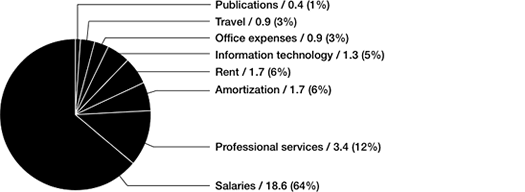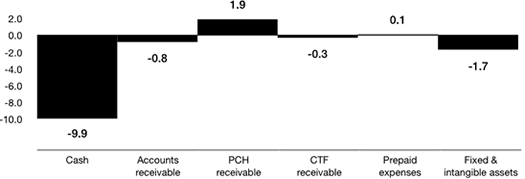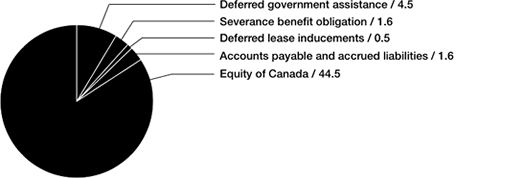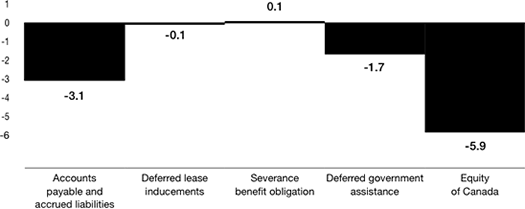Analysis of expenses
Assistance Expenses
Assistance expenses are program expenses incurred mainly to fund clients.
Canada Feature Film Fund
In 2009-2010, CFFF
assistance expenses reached the highest levels in the history of the
Fund ($99.2M), an increase of $4.7M over 2008-2009. That increase is due
mainly to greater emphasis on the production and marketing assistance
program within the CFFF. The available funds committed on a yearly basis
are known in advance, and Telefilm expects a pullback in assistance
expenses to 2008-2009 levels for 2010-2011. More detail of CFFF expenses
is disclosed in Schedule A of the Financial Statements.
Assistance expenses for CFFF ($M)
About 86% of the $99.2M of funding in 2009-2010 was
appropriated from parliament. Recoveries from investments and forgivable
advances make up most of the remainder.
Funding sources for CFFF ($M)
- Others
- APTN
- Recoveries
- Parliamentary appropriation
Recoveries utilization is up by $4.6M compared to last year.
This represents an important funding source for Telefilm since amounts
recovered from earlier investments enable a greater number of projects
to be funded.
Since the level of parliamentary appropriation is stable, the
utilization of recoveries, whether they are coming from actual or
previous fiscal, is subject to the levels of assistance expenses
resulting in a higher utilization of recoveries in CFFF assistance.
However, total annual recoveries took a plunge in 2009-2010
from $11.9M to $8.5M. Two factors influence annual recoveries: domestic
and international sales. For this fiscal year, only two films financed
by Telefilm were successful enough in domestic sales to generate
significant return on investment. In addition, unlike 2008-2009, no
films reported significant recoveries on international sales.
Telefilm follows its recoveries closely to ensure that annual
projections are realistic. The existence of a trend is not conclusive
and recoveries are forecast to be up slightly to $10M for 2010-2011. The
situation may warrant a mid-year review by management.
Canada New Media Fund
After 12 years of administration by Telefilm, the CNMF, in its various forms, was wound up this fiscal year. The Department of Canadian Heritage
(PCH) has not renewed the Contribution Agreement for the next fiscal
year in its current form. For 2010-2011 and beyond, this federal
assistance to the new media industry will be delivered through the Canada Media Fund (CMF). The related Programs funding will be administered by Telefilm through a Services Agreement with the CMF.
Assistance expenses for CNMF ($M)
In its final year, CNMF assistance expenses stayed relatively
stable at $13.2M. PCH funded 86% of the CNMF assistance expenses
($11.4M) through a Contribution Agreement. Accumulated recoveries from
the previous fiscal years ($1.8M) completed the assistance expenses
funding.
Funding sources for CNMF ($M)
- Parliamentary appropriation
- Recoveries
- PCH
Under the Contribution Agreement, Telefilm has been obligated to remit all fund-related recoveries to the Consolidated Revenue Fund of Canada
since fiscal 2007-2008. Telefilm was able to remit slightly more than $0.5M for fiscal 2009-2010.
Operating and Administrative Expenses
The following pie chart outlines the amounts and percentages
of Telefilm’s operating and administrative expenses by financial
statement line item. More detail about operating and administrative
expenses is disclosed in Schedule D of the Financial Statements.
Operating and administrative expenses: $28.9M
Telefilm closely monitors its budget capacity and the necessity
of its expenses. Overall operating and administrative expenses were
down 7% in 2009-2010, from $31.1M to $28.9M.
Operating and administrative expenses are incurred to deliver
CFFF programs and activities, to fulfill the Services Agreement signed
with the CTF for the delivery of its program funding, for CNMF programs,
and for corporate responsibilities such as governance.
Telefilm’s control over its expenses is evident—decreases in
costs outnumber and outweigh increases. The most important cost saving
came from professional services which dropped $1.8M over last year. This
is mainly due to a significant accrued charge recorded in 2008-2009
that was resolved this fiscal year.
Operating and administrative expenses $-2.2M Variances 2009-2010 vs 2008-2009
Government Funding and Revenues
Telefilm has three main sources of funding: parliamentary appropriation, CNMF Contribution Agreement, and CTF
management fees related to a Services Agreement.
Parliamentary appropriation fell $3.2M in 2009-2010 mainly due
to the termination of the National Training School Program ($2.5M) and
the Interdepartmental Partnership with Official-Language Communities
Program ($0.6M). Parliamentary appropriation is expected to pull back
slightly to $105.4M for fiscal year 2010-2011.
CNMF revenues from the Contribution Agreement decreased by $1M
to $13M. This reduction is due to the closing of the fund and
Telefilm’s requirement to reinvest its accumulated recoveries. No
Contribution Agreement revenue will come from the CNMF next year.
CTF management fees are up slightly by $0.2M to $7.9M. Telefilm has also been mandated on behalf of the Canada Media Fund (CMF)
to deliver its new programs, and related management fees are expected to be close to $10M for next fiscal year.
Parliamentary appropriation ($M)
Other important funding sources: $21.4M
- CNMF (PCH) 13.0
- CTF management fees 7.9
- APTN 0.5
- PCH (Professional training shcools) 0.0



















